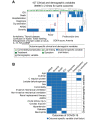Identification of Risk Factors and Symptoms of COVID-19: Analysis of Biomedical Literature and Social Media Data
- PMID: 32936770
- PMCID: PMC7537723
- DOI: 10.2196/20509
Identification of Risk Factors and Symptoms of COVID-19: Analysis of Biomedical Literature and Social Media Data
Abstract
Background: In December 2019, the COVID-19 outbreak started in China and rapidly spread around the world. Lack of a vaccine or optimized intervention raised the importance of characterizing risk factors and symptoms for the early identification and successful treatment of patients with COVID-19.
Objective: This study aims to investigate and analyze biomedical literature and public social media data to understand the association of risk factors and symptoms with the various outcomes observed in patients with COVID-19.
Methods: Through semantic analysis, we collected 45 retrospective cohort studies, which evaluated 303 clinical and demographic variables across 13 different outcomes of patients with COVID-19, and 84,140 Twitter posts from 1036 COVID-19-positive users. Machine learning tools to extract biomedical information were introduced to identify mentions of uncommon or novel symptoms in tweets. We then examined and compared two data sets to expand our landscape of risk factors and symptoms related to COVID-19.
Results: From the biomedical literature, approximately 90% of clinical and demographic variables showed inconsistent associations with COVID-19 outcomes. Consensus analysis identified 72 risk factors that were specifically associated with individual outcomes. From the social media data, 51 symptoms were characterized and analyzed. By comparing social media data with biomedical literature, we identified 25 novel symptoms that were specifically mentioned in tweets but have been not previously well characterized. Furthermore, there were certain combinations of symptoms that were frequently mentioned together in social media.
Conclusions: Identified outcome-specific risk factors, symptoms, and combinations of symptoms may serve as surrogate indicators to identify patients with COVID-19 and predict their clinical outcomes in order to provide appropriate treatments.
Keywords: COVID-19; SARS-CoV-2; Twitter; biomedical literature; diagnosis; risk factor; social media; symptom; treatment; tweets.
©Jouhyun Jeon, Gaurav Baruah, Sarah Sarabadani, Adam Palanica. Originally published in the Journal of Medical Internet Research (http://www.jmir.org), 02.10.2020.
Conflict of interest statement
Conflicts of Interest: None declared.
Figures




Similar articles
-
Using Reports of Symptoms and Diagnoses on Social Media to Predict COVID-19 Case Counts in Mainland China: Observational Infoveillance Study.J Med Internet Res. 2020 May 28;22(5):e19421. doi: 10.2196/19421. J Med Internet Res. 2020. PMID: 32452804 Free PMC article.
-
Temporal and Location Variations, and Link Categories for the Dissemination of COVID-19-Related Information on Twitter During the SARS-CoV-2 Outbreak in Europe: Infoveillance Study.J Med Internet Res. 2020 Aug 28;22(8):e19629. doi: 10.2196/19629. J Med Internet Res. 2020. PMID: 32790641 Free PMC article.
-
Epidemiology and clinical characteristics of 43 COVID-19 patients in Weifang, China.Ann Palliat Med. 2020 Sep;9(5):2993-2999. doi: 10.21037/apm-20-537. Epub 2020 Aug 14. Ann Palliat Med. 2020. PMID: 32819125
-
Identifying common baseline clinical features of COVID-19: a scoping review.BMJ Open. 2020 Sep 16;10(9):e041079. doi: 10.1136/bmjopen-2020-041079. BMJ Open. 2020. PMID: 32938604 Free PMC article.
-
ENT manifestation in COVID-19 patients.Auris Nasus Larynx. 2020 Aug;47(4):559-564. doi: 10.1016/j.anl.2020.06.003. Epub 2020 Jun 15. Auris Nasus Larynx. 2020. PMID: 32586739 Free PMC article. Review.
Cited by
-
Google Trends for Pain Search Terms in the World's Most Populated Regions Before and After the First Recorded COVID-19 Case: Infodemiological Study.J Med Internet Res. 2021 Apr 22;23(4):e27214. doi: 10.2196/27214. J Med Internet Res. 2021. PMID: 33844638 Free PMC article.
-
The prevalence of symptoms and its correlation with sex in polish COVID-19 adult patients: Cross-sectional online open survey.Front Med (Lausanne). 2023 Apr 5;10:1121558. doi: 10.3389/fmed.2023.1121558. eCollection 2023. Front Med (Lausanne). 2023. PMID: 37089602 Free PMC article.
-
A chronological and geographical analysis of personal reports of COVID-19 on Twitter from the UK.Digit Health. 2022 May 5;8:20552076221097508. doi: 10.1177/20552076221097508. eCollection 2022 Jan-Dec. Digit Health. 2022. PMID: 35574580 Free PMC article.
-
Longitudinal Changes of COVID-19 Symptoms in Social Media: Observational Study.J Med Internet Res. 2022 Feb 16;24(2):e33959. doi: 10.2196/33959. J Med Internet Res. 2022. PMID: 35076400 Free PMC article.
-
Toward Using Twitter for Tracking COVID-19: A Natural Language Processing Pipeline and Exploratory Data Set.J Med Internet Res. 2021 Jan 22;23(1):e25314. doi: 10.2196/25314. J Med Internet Res. 2021. PMID: 33449904 Free PMC article.
References
-
- COVID-19 Coronavirus Pandemic. Worldometer. 2020. [2020-09-30]. https://www.worldometers.info/coronavirus.
-
- Guan W, Ni Z, Hu Y, Liang W, Ou C, He J, Liu L, Shan H, Lei C, Hui DSC, Du B, Li L, Zeng G, Yuen K, Chen R, Tang C, Wang T, Chen P, Xiang J, Li S, Wang J, Liang Z, Peng Y, Wei L, Liu Y, Hu Y, Peng P, Wang J, Liu J, Chen Z, Li G, Zheng Z, Qiu S, Luo J, Ye C, Zhu S, Zhong N, China Medical Treatment Expert Group for Covid-19 Clinical Characteristics of Coronavirus Disease 2019 in China. N Engl J Med. 2020 Apr 30;382(18):1708–1720. doi: 10.1056/NEJMoa2002032. http://europepmc.org/abstract/MED/32109013 - DOI - PMC - PubMed
-
- Wu C, Chen X, Cai Y, Xia J, Zhou X, Xu S, Huang H, Zhang L, Zhou X, Du C, Zhang Y, Song J, Wang S, Chao Y, Yang Z, Xu J, Zhou X, Chen D, Xiong W, Xu L, Zhou F, Jiang J, Bai C, Zheng J, Song Y. Risk Factors Associated With Acute Respiratory Distress Syndrome and Death in Patients With Coronavirus Disease 2019 Pneumonia in Wuhan, China. JAMA Intern Med. 2020 Jul 01;180(7):934–943. doi: 10.1001/jamainternmed.2020.0994. http://europepmc.org/abstract/MED/32167524 - DOI - PMC - PubMed
-
- Kohlmeier S, Lo K, Wang LL, Yang YY. COVID-19 Open Research Dataset Challenge (CORD-19) Zenodo. 2020 Mar;:e. doi: 10.5281/zenodo.3727291. https://pages.semanticscholar.org/coronavirus-research - DOI
Publication types
MeSH terms
Substances
LinkOut - more resources
Full Text Sources
Other Literature Sources
Miscellaneous

